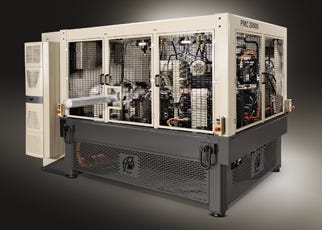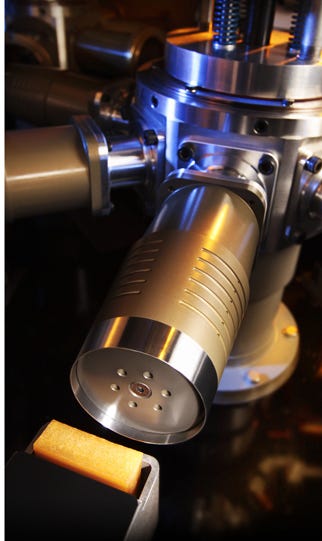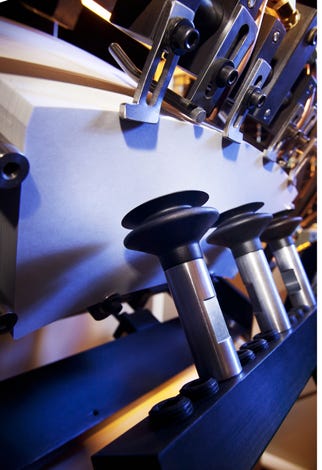
PMC 1.jpg
The paper cup is one of the most common containers we encounter every day. Yet, as with many of the seemingly simple packages we routinely use, the best forming machines to make paper cups and paperboard canisters use advanced engineering and system design, combined with high-performance components that can sustain production of thousands of containers per hour, 24 hours a day.
Paper Machinery Corp. is one of the world's leading sources of high-performance forming machines for paper cups, paperboard canisters and custom paperboard packages. With 1,500-plus installations in more than 45 countries, PMC has an in-depth understanding of the evolving paper container needs of converters, food service and beverage company suppliers.
PMC recently decided to create a new paper container forming machine engineered to provide a more flexible platform for faster, easier tooling changeovers to support a wider range of container sizes and dimensions. This is the PMC 2000S-the industry's first fully servo-driven forming machine. To control the new PMC 2000S, PMC chose a complete servo drive, motor and motion control platform from the drive and control experts at Bosch Rexroth Corp.
Flexibility in high demand
Globally, consumer goods providers are introducing an ever-greater variety of products
PMC 2.jpg
to satisfy regional, ethnic, lifestyle, age-related and gender-specific tastes. This is driving a demand for paper forming machines that are capable of running different containers-sometimes two, three or four different containers-in a single week.
PMC is an expert at building industry-leading machinery. Prior to its newest machine, all of the company's platforms used a mechanical drive shaft and cams to power the main machine components. "For a growing segment of customers, you need to run multiple sets of tooling on one machine," says John Baumgartner, president of PMC. "Our servo-driven machine is going to be significantly better for customers with that kind of tooling changeover requirement."
The "S" stands for servo
The new PMC 2000S is an 18-axis machine with three main sections: a transfer turret that feeds the container sidewalls into the machine; a transfer turret that indexes the sidewalls through multiple wrapping, gluing, seaming and bottom applications stations; and a rimming turret for curling the top rim of the container.
This configuration-the "top" of the machine-is similar to other PMC machines. The difference with the PMC 2000S is the complete Rexroth IndraMotion MLC (Motion Logic in Controller) motion, logic and drive platform that controls the system. Combined with advanced Rexroth IndraDyn T direct-drive motors and compact IndraDrive Cs servo drives, Rexroth equipped the PMC 2000S with a fully integrated drive and control platform capable of producing up to 200 cups/min.
Just as importantly, the Rexroth IndraMotion MLC platform replaces mechanical cams with digital electronic cams for each of the 18 machine axes. It creates an operating framework that will support much faster product changeovers. "Imagine changing from one complete tool set to another in a single shift," Baumgartner says. "In addition, each station on the machine runs its own unique electronic cam profile-one that has been optimized to that station's motion, and is integrated and synchronized with the entire machine."
Rexroth's IndraMotion MLC is an integrated, controller-based motion logic platform that combines innovative software and firmware capabilities with printing and converting industry-specific technology functions. It features extensive motion sequence software libraries to give machine builders maximum flexibility to configure the optimum controls platform for its application.
IndraMotion MLC also provides a sophisticated array of programming tools to build and fine-tune electronic cams and motion sequences-tools that gave Rexroth an critical advantage as PMC assessed which platform to use to control the PMC 2000S.
PMC had used Rexroth servo technology for infeed subsystems on its machines in the past, according to Liz Lind, controls manager at PMC. For this project, she says multiple servo component suppliers and integrators were evaluated, including Rexroth with its local automation distributor partner CMA/Flodyne/Hydradyne (CMAFH). "We invited them to participate in a competitive comparison, putting its servo drive platforms and direct drives on a test mandrel turret, so that PMC could assess a broad range of performance parameters," she says.
Each supplier designed and engineered a control, drive and 
PMC 3.jpg
motor platform and installed it on the test mandrel turret. PMC then tested each company's platform, assessing its ease of use, ability to carry out a full range of motion sequences and system tuning and diagnostic tools.
"We took many different kinds of readings; whatever its systems provided, such as oscilloscope traces," Lind says. "Rexroth has an excellent scope-trace system in its IndraMotion platform, and we continually used it to tune the motors and test its position. Based on the performance of the direct drive motors, the control system and the troubleshooting system, Rexroth was the clear winner."
Invaluable cam building tool
Once the IndraMotion MLC platform was chosen, building and refining the electronic cams was one of the most critical engineering steps. Rexroth's CamBuilder program was the perfect solution to this challenge. CamBuilder is a Windows-based software tool specially designed to enable fast, sophisticated design, testing and fine-tuning of electronic cams. Lind says her team found CamBuilder to be invaluable. "It's extremely easy to use, and it provides many different profile types and options to build your cam table," she says. "Once you've built your table, you can numerically enter motion sequence information and see it as a graphical depiction. You can also move the graphic and see the numeric values change."
Lind says CamBuilder also enabled PMC to export .csv files, which can be imported into an Excel spreadsheet, and convert it into an AutoCAD drawing to visualize an axis' real-world motion. And by using the oscilloscope capabilities in the IndraMotion platform, Lind says they can run each machine axis separately or in combination, capture motion data and verify that the real-world motion results are the same as the theoretical.
"In the theoretical world, you may build something, but in the real world, the mechanical apparatus may have stiffness or backlash, so you're not at the exact point where you think you should be," Lind says. "With the tools that the Rexroth platform offers, we can build a cam table and verify its solidity."
Another valuable feature the IndraMotion platform offers is remote diagnostics. PMC can access any PMC 2000S controls platform anywhere over the Internet and troubleshoot machine issues down to individual servo drives. This will significantly increase machine uptime and reduce maintenance and support costs.
Precision power
One of the other engineering challenges presented by the PMC 2000S was selecting and sizing the motors for each axis; in particular, the direct drive motors to turn the mandrel turret, transfer turret and gripper turret. According to Lind, the motors for these turrets needed to move profiles that were very demanding. "The profile that we move is very aggressive, very exact and needs to finish in an exact amount of time," she says. "The strength and high pole count of the Rexroth direct drive motor, which drives the mandrel turret, is able to accomplish this motion where none of the other supplier's direct-drive motors could."
Rexroth's IndraDyn T series of torque direct-drive motors are optimized for high torques of up to 13,800 Nm (newton meter). They feature high pole counts that enable exceptionally rigid, stable motion and high stiffness at endpoints. This enabled PMC to satisfy another key machine requirement: stopping the machine motion within one index when needed (such as if a container fails to be ejected on the cup diverter) without harming either the machine's mechanical systems or the drive itself.
PMC has targeted its new machine at a segment of the paper cup and container manufacturing market that seeks a lower-cost machine. According to PMC's Baumgartner, the Rexroth servo drive platform is helping accomplish this goal.
Lind added that one of the keys to improving PMC's ability to develop the P
PMC 4.jpg
MC 2000S faster is the engineering support and insight provided by Rexroth and CMAFH, who not only provided onsite programming and sizing help, but also local stock of components.
"One of the reasons we chose Rexroth and CMAFH is because of their flexibility and excellent engineering support," she says. "It's a different control system than what we've used in the past, and they were eager to help us learn it. We worked very well together to design this package."
Bosch Rexroth Corp., 800-739-7684.
www.boschrexroth-us.com
CMA/Flodyne/Hydradyne,
262-781-1815. www.cmafh.com
Paper Machinery Corp.,
414-362-8231. www.papermc.com
About the Author(s)
You May Also Like


